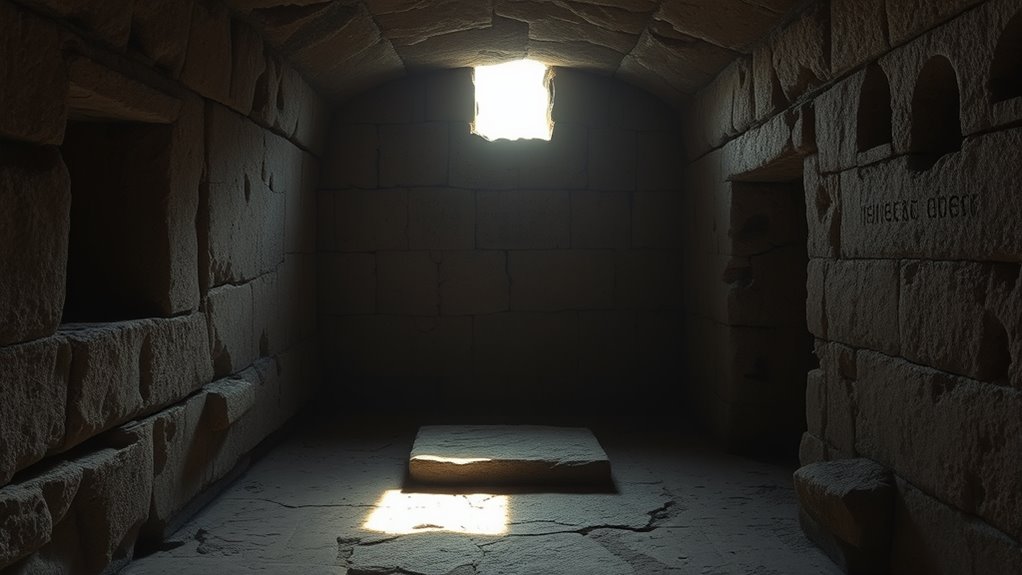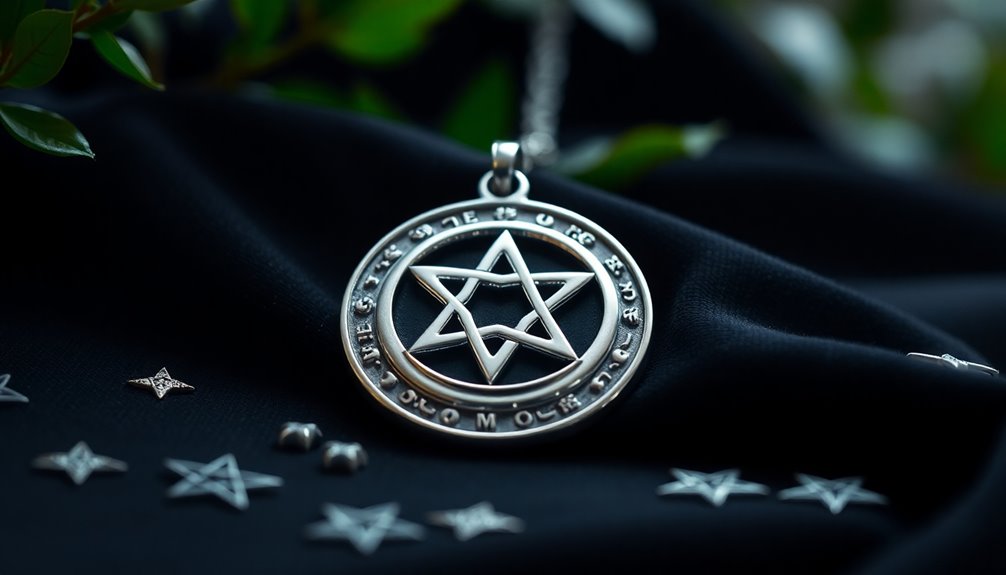Historical and archaeological evidence shows that Jesus’ tomb was believed to be empty based on Gospel accounts and traditions, but no definitive archaeological proof exists. Many explanations, from body theft to natural decomposition, have been proposed, while some see the empty tomb as a symbol of hope from resurrection stories. Skeptics question the physical evidence, suggesting stories may be mythic or symbolic. To understand the complexities and different perspectives, explore what the evidence truly reveals.
Key Takeaways
- Gospel accounts consistently report an empty tomb, but details vary across sources with some emphasizing symbolic themes.
- No definitive archaeological evidence confirms Jesus’ tomb or its emptiness, and discoveries of similar tombs are inconclusive.
- Theories like body theft or misidentification attempt to explain the empty tomb but lack concrete historical proof.
- Cultural burial customs and rapid body handling after death support the historical plausibility of the tomb’s emptiness.
- Interpretations of the empty tomb often differ, with some viewing it as a literal event and others as symbolic or mythological.
Historical Accounts of Jesus’ Burial
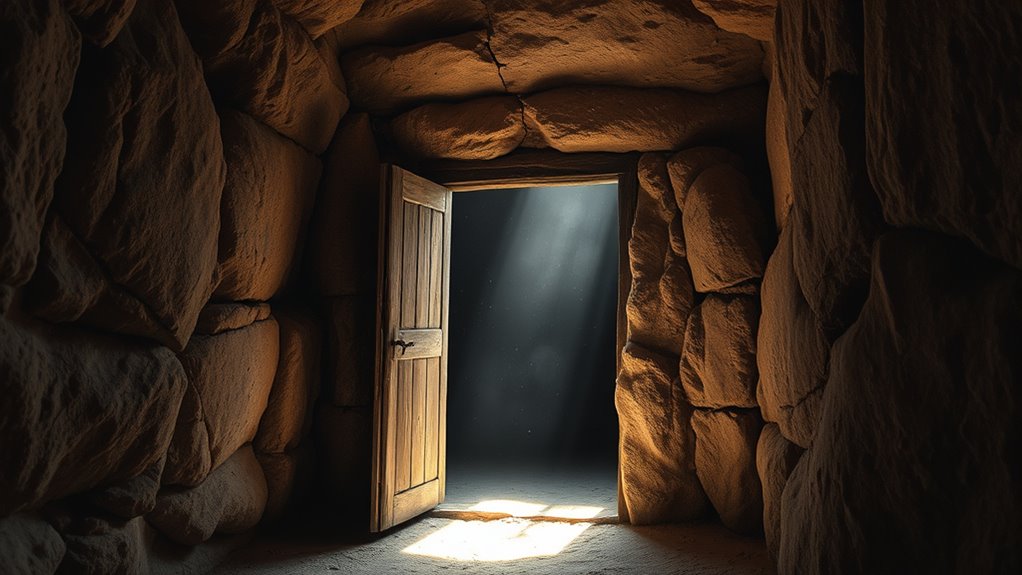
Historical accounts of Jesus’ burial provide the foundation for understanding what happened to his body after the crucifixion. These records highlight the funeral customs and burial rituals typical of the time, giving context to how Jesus was laid to rest. According to these sources, Joseph of Arimathea, a respected figure, requested Pilate for Jesus’ body, which was then wrapped in linen and placed in a new tomb. Burial rituals during that era emphasized respect and reverence for the deceased, often involving careful preparation and a designated burial site. These traditions help explain why Jesus’ body was handled with care and placed in a tomb. Understanding these historical funeral customs allows you to appreciate the significance of the burial process in early Christian narratives.
The Gospel Narratives and Their Consistency
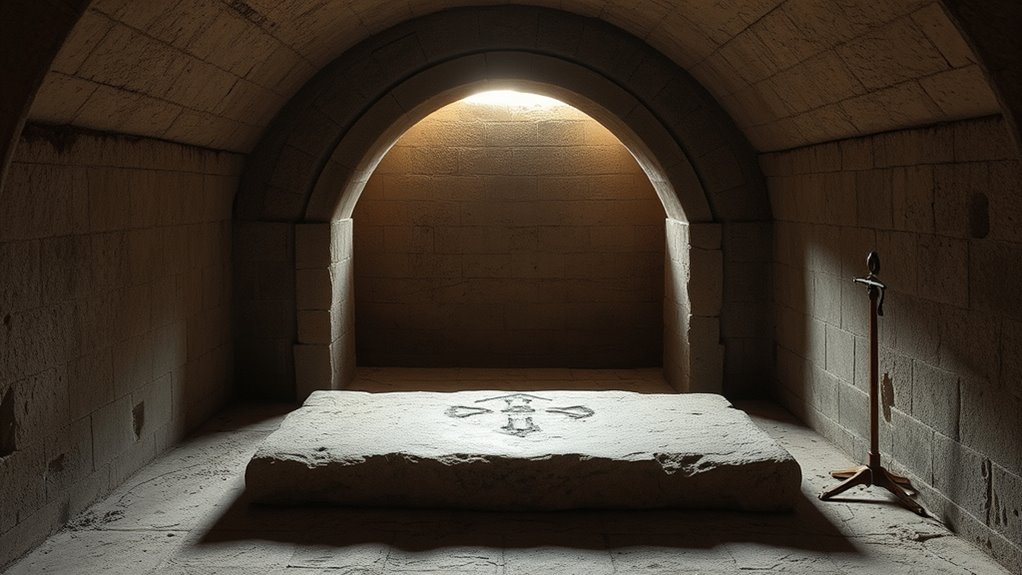
The gospel accounts provide detailed narratives about what happened after Jesus’ burial, offering different perspectives on the events surrounding his resurrection. These stories vary in details, reflecting both symbolic interpretations and their cultural contexts. For example, some Gospel writers emphasize appearances of Jesus to his followers, highlighting spiritual truths beyond literal events. Others focus on specific details about the tomb and the women who discovered it empty, which may serve symbolic purposes or reflect cultural sensitivities of the time. Despite differences, the core message of an empty tomb remains consistent across accounts. These variations don’t necessarily undermine their reliability; instead, they reveal how early followers interpreted Jesus’ resurrection within their cultural frameworks, shaping the narratives to resonate with their audiences.
Archaeological Evidence and Tomb Discoveries

Archaeologists have uncovered ancient burial sites that shed light on early burial practices, but none have been definitively linked to Jesus’s tomb. Recent discoveries of tombs from the same period spark debates about their relevance to the story. As new finds emerge, they prompt you to ponder how archaeological evidence supports or challenges the claims about Jesus’s burial and resurrection.
Ancient Burial Sites
Although definitive evidence remains elusive, numerous ancient burial sites have provided valuable insights into early Jewish burial practices and the types of tombs used during the first century. Through tomb archaeology, researchers have uncovered various burial structures, including rock-cut tombs and family tombs, which reveal how people honored their dead. These sites help us understand the cultural context of Jesus’ time, showing that tombs were often carved into rock and sealed with stone slabs. Many of these ancient burial sites contain ossuaries and burial chambers, illustrating the significance of preserving remains. While these discoveries don’t directly confirm or deny the empty tomb story, they offer important background on burial customs, making it easier to interpret the archaeological and historical landscape of first-century Jerusalem.
Recent Archaeological Finds
Recent archaeological discoveries have shed new light on the tombs and burial practices of first-century Jerusalem, offering fresh perspectives on the context of Jesus’ burial. These finds help you understand how burial sites often intertwined spiritual symbolism with everyday life, sometimes blending mythical narratives with historical reality. Recent excavations reveal tombs with ossuaries and inscriptions that reflect cultural beliefs about afterlife and spiritual continuity. The table below highlights key differences:
| Burial Practice | Spiritual Symbolism |
|---|---|
| Rock-cut tombs | Connection to divine protection |
| Ossuaries | Memory and spiritual remembrance |
| Burial niches | Transition to afterlife |
| Tomb inscriptions | Conveying spiritual messages |
These discoveries challenge simplistic views, showing how burial practices incorporated mythical narratives and spiritual symbolism, shaping early beliefs about life after death.
The Role of Early Christian Traditions

Early Christian traditions played a essential role in shaping how believers understood and remembered Jesus’ resurrection. These traditions drew heavily on Jewish burial customs, which involved careful preparation of the body and placement in a tomb. They also referenced Roman execution methods, particularly crucifixion, to explain Jesus’ death. Early followers believed Jesus’ body was laid in a tomb quickly after death, consistent with Jewish customs to prevent desecration. These traditions helped establish the belief that the tomb was initially occupied but later found empty. Over time, stories emphasizing the empty tomb became central to Christian identity, reinforcing the idea of resurrection. These early traditions, consequently, serve as critical sources for understanding how the early Christian community interpreted the events surrounding Jesus’ death and burial.
Alternative Explanations for the Empty Tomb
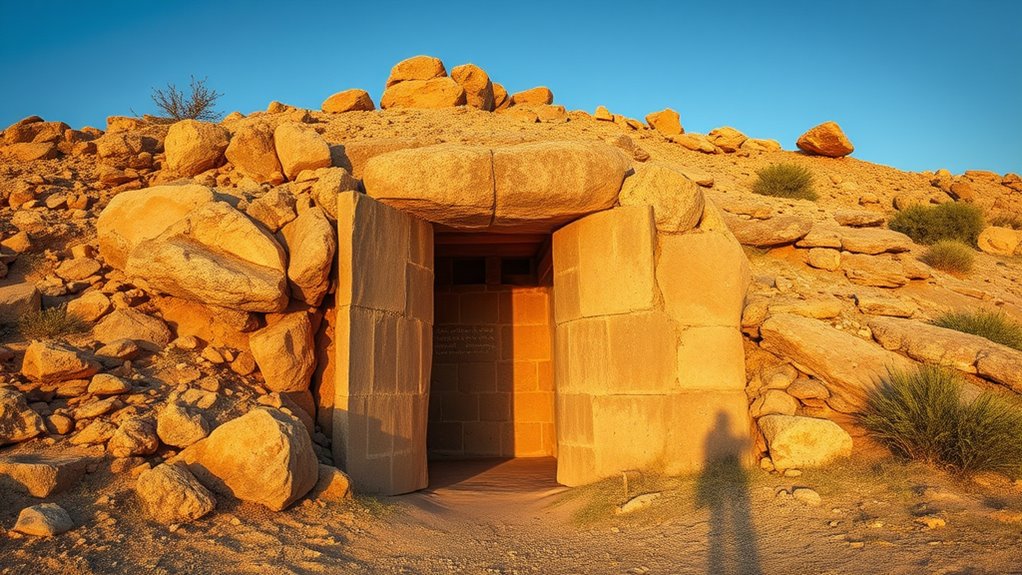
You might consider alternative explanations like body theft or the possibility that the tomb was misidentified. Natural causes, such as decomposition, could also explain why the body was no longer there. Exploring these options helps us understand the different ways the tomb’s emptiness could be interpreted.
Possible Body Theft
One plausible explanation for the empty tomb is that Jesus’ body was stolen. Grave robbing or body snatching was common in ancient times, and criminals or even mourners could have taken Jesus’ body for various reasons. If someone wanted to prevent Jesus’ followers from honoring him properly, they might have stolen the body to create confusion or discredit the resurrection claims. In some cases, bodies were taken to sell or use in pagan rituals. The disciples’ belief in Jesus’ resurrection could then be explained as a mistaken belief that his body was missing, rather than a supernatural event. While this theory offers a natural explanation, it relies on assumptions about grave robbing that historical evidence doesn’t strongly support for Jesus’ tomb specifically.
Misidentification of Tomb
Some scholars suggest that the tomb thought to belong to Jesus may have been misidentified, which could explain why it appeared empty. Tomb misidentification occurs when burial sites are confused or mislabeled, especially in crowded or chaotic settings. Burial confusion was common in ancient Jerusalem, where multiple tombs and family crypts existed close together. If early followers visited the wrong tomb, they might have believed Jesus’ body was missing when, in fact, it was simply buried elsewhere. This misunderstanding could account for the reports of the empty tomb without requiring resurrection. While this explanation doesn’t prove what actually happened, it offers a plausible reason for the discrepancy and highlights the potential for burial confusion to lead to mistaken assumptions about Jesus’ burial site.
Natural Causes of Decomposition
Natural processes such as decomposition could have caused the body of Jesus to decay rapidly, making his tomb appear empty over time. The decomposition process involves natural decay, where bacteria and enzymes break down tissues, leading to the body’s disintegration. Factors like temperature, humidity, and burial conditions accelerate this process, especially in warm or moist environments. If Jesus was buried without proper preservation, his body would have undergone significant decay, possibly disappearing completely within days or weeks. This natural decay could explain the empty tomb, as the body would no longer be present. Understanding the natural decomposition process helps evaluate whether the tomb’s emptiness was due to biological causes rather than supernatural or intentional removal.
The Significance of Resurrection Beliefs
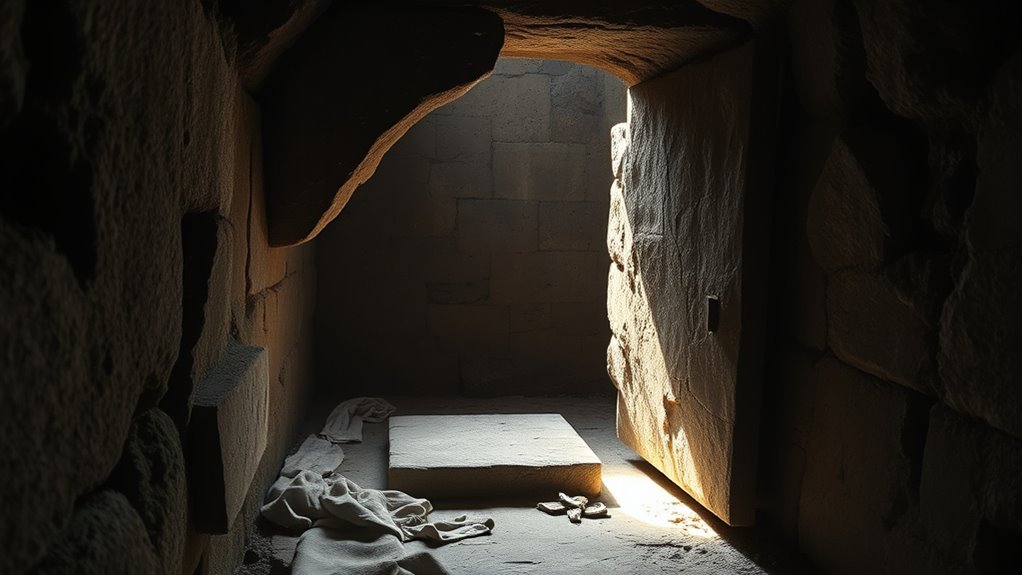
The beliefs about Jesus’ resurrection hold profound significance because they shape how you understand life, death, and divine authority. For many followers, the resurrection isn’t just a historical event but a powerful symbolic interpretation of hope, renewal, and eternal life. These beliefs reinforce the idea that divine power can overcome death, offering reassurance and purpose. Over time, resurrection stories also contributed to myth development within early Christian communities, emphasizing themes of transformation and victory over mortality. Such stories helped solidify faith and provided a foundation for moral and spiritual teachings. Ultimately, these beliefs continue to influence how you perceive suffering, salvation, and the divine, making the resurrection a cornerstone of Christian identity and hope.
Challenges From Skeptical Perspectives

Skeptical perspectives challenge the idea that Jesus’ tomb was truly empty by questioning the historical and physical evidence. Some argue that mythical interpretations of resurrection stories suggest they are symbolic rather than literal events, making the empty tomb story less credible. Scientific skepticism raises doubts about miraculous claims, emphasizing that extraordinary events require extraordinary proof. Critics point out that the lack of physical remains or definitive archaeological evidence weakens the case for an actual empty tomb. They also highlight inconsistencies in gospel accounts and suggest the story could have developed as a myth over time, rather than reflecting historical fact. These perspectives encourage a cautious approach, urging you to scrutinize the evidence critically and question assumptions about what truly happened.
Reassessing the Evidence: What Do We Know?
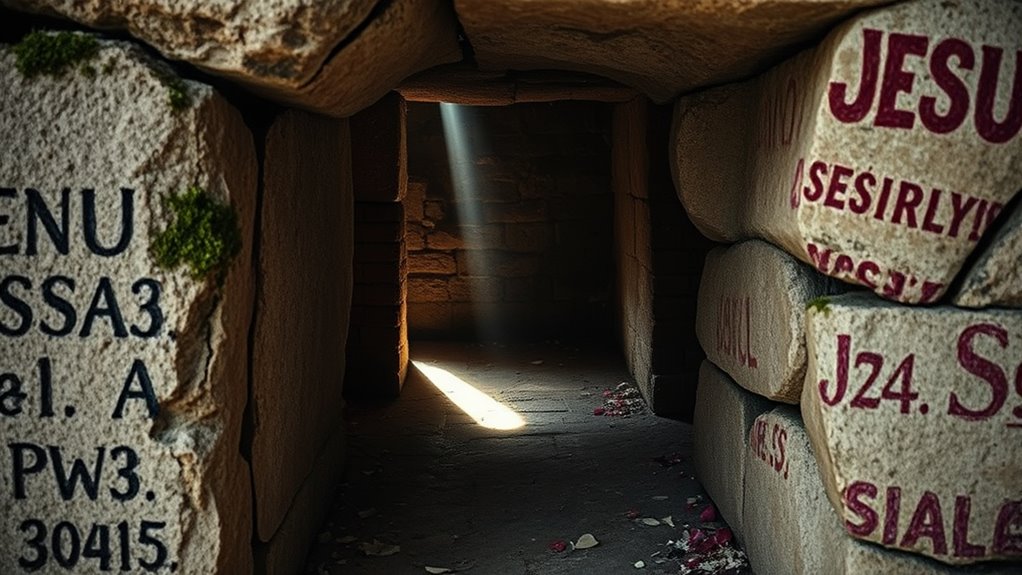
Reassessing the evidence requires carefully examining what historical and archaeological sources actually tell us about Jesus’ tomb. While physical evidence is limited, cultural symbolism offers insight into how early believers viewed Jesus’ resurrection. The development of myths around Jesus’ death and resurrection shaped perceptions, but these stories also reflect deeper religious meanings rather than straightforward historical facts. Understanding this helps avoid assuming all narratives are literal accounts. Instead, you recognize that early Christian symbols and stories served to inspire faith and community identity, not necessarily document physical details. By considering both archaeological findings and the cultural symbolism behind these stories, you get a clearer picture of what scholars can confidently know—and what remains open to interpretation—about Jesus’ tomb and the resurrection claims.
Frequently Asked Questions
How Do Different Religious Traditions Interpret the Empty Tomb?
When exploring how different religious traditions interpret the empty tomb, you see diverse perspectives shaping interfaith dialogue. Christians view it as a sign of Jesus’ resurrection and divine victory, while some Jewish traditions see it as a symbolic story. These interpretations often reflect theological symbolism, fostering understanding across faiths. You recognize that discussing these differences helps deepen respect and promotes meaningful conversations about faith, history, and spiritual meaning.
What Cultural Factors Influenced Early Christian Beliefs About Jesus’ Resurrection?
You might be surprised to learn that over 2,000 years ago, cultural symbolism and ritual practices deeply shaped early Christian beliefs about Jesus’ resurrection. These practices reinforced the idea of new life and divine victory, making the resurrection central to faith. Rituals like baptisms symbolized rebirth, while cultural symbols conveyed hope and renewal. Such influences helped early Christians embrace and spread the belief in Jesus’ rising from the dead.
Are There Any Non-Christian Sources That Mention Jesus’ Burial or Resurrection?
You’ll find that secular historical accounts and archaeological evidence offer limited references to Jesus’ burial or resurrection. Non-Christian sources like Tacitus and Josephus mention Jesus’ death but don’t detail his burial or resurrection. Archaeological evidence related to Jesus’ tomb is scarce and inconclusive. While these sources support some historical aspects, they don’t provide direct evidence of the resurrection, leaving much to faith and interpretation.
How Do Modern Forensic Methods Contribute to Understanding Ancient Tombs?
Modern forensic methods like DNA analysis and forensic archaeology help you examine ancient tombs more accurately. You can uncover details about the remains, burial practices, and any potential evidence of disturbance. These techniques allow you to analyze bones and artifacts non-invasively, offering insights into historical events. By applying forensic science to ancient sites, you gain a clearer understanding of past lives and burial customs, bringing new perspectives to historical and religious discussions.
Could Natural Disasters Have Affected the Preservation of Jesus’ Tomb?
Imagine the earth as a restless artist, constantly reshaping its canvas with geological upheavals. These natural disasters could have shaken Jesus’ tomb, causing accidental damage or even altering its structure over time. Such upheavals might have disturbed the resting place, making it less pristine and potentially hiding or destroying evidence of an empty tomb. So, yes, natural disasters could have played a part in its preservation—or lack thereof.
Conclusion
Ultimately, the question of Jesus’ empty tomb remains complex. While historical texts and early traditions support the resurrection, archaeological evidence is inconclusive. Skeptics suggest alternative explanations, but the consistency of Gospel accounts and the profound impact on Christian faith suggest something significant happened. You can consider that the empty tomb’s true meaning may blend historical uncertainty with spiritual conviction, leaving the question open to personal interpretation and ongoing investigation.

